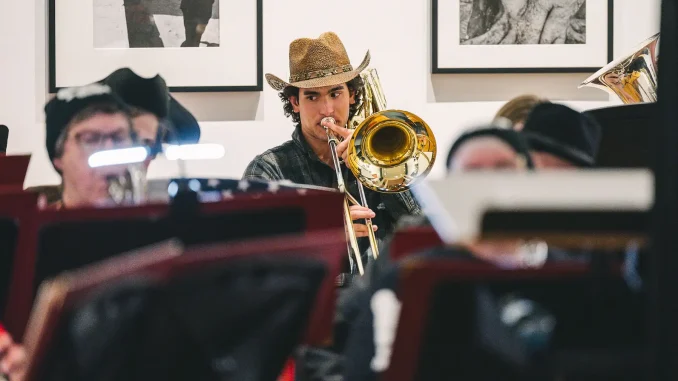
The Ursinus College Wind Ensemble has seen tremendous growth in their last few seasons both internally and externally. The size of the band has increased dramatically over the years, and, as a result, so has its community outreach. But as little as three seasons ago, the future prospects of the Ensemble were, like their Halloween performance, spooky.
I was graciously welcomed to observe the last two rehearsals the group had before their Halloween performance which, by the time this issue is released, will have taken place at the Berman Museum on October 29th. In conjunction with the Collegeville Rotary Halloween Fest happening the same night, the Ensemble presented a public show featuring several spooky classics, all encompassing a spirit of whimsy and Halloween thrills. Consistent with the theme of the show, the individual works planned were grand and exciting. After speaking closely with the director, Professor Harry Oehler, I discovered that such extravagance would have been much harder to accomplish three seasons ago, when the band was nearly a quarter of the size it is today.
“In my first season, we were much smaller – maybe a dozen students and two programs a year,” Oehler explained to me. Despite the many talented musicians who contributed their time and passion to the group back then, the college alone simply could not supply all the personnel required for certain pieces and events. Though starting to dim, a flame was still lit within the heart of the small band back then, and the group was determined to keep it alive. So, they did the difficult thing: they asked for help. And the response was astounding.
Quickly and perhaps unexpectedly, community members, including families/friends of student musicians, music students outside of Ursinus, Ursinus alumni, faculty and staff, and other local musicians came to the Ensemble’s aid and uplifted the band to what it is today. Abigail, a member of the Ursinus of the class of 2027 and a member of the Ensemble since her first year, reflected on the growth she saw straight after the community got involved. “Last spring…” she recalled, “the band was split into one-fourth community members, one-fourth staff, one-fourth students, and one-fourth alumni.” This community involvement catalyzed a growth that has continued ever since.
In addition to the sheer physical growth in numbers, allowing for more opportunities for music and events, the group grew greatly in diversity. Thanks to their expansion and inclusivity, the demographics represented in the Ensemble widened dramatically. Though I did not run an official statistical analysis, I can guess the age range in the Ensemble is somewhere from eighteen to at least eighty-two (based on an older alum I spoke to), and the band consists of friends, couples, students and staff, and individual musicians from truly all walks of life. The members expressed great pride in this fact, and Oehler shared this sentiment; he told me that he “…[loves] those first rehearsals when [he gets] to tell people ‘Say hi to your neighbor and ask them something about themselves!’” because many of them have never met prior. Beyond making new friends, this diversity allows for greater learning experiences for members due to the range of musical experience also represented in the group. While some players in the Ensemble have performed on professional stages, others are picking up their instrument for the first time since high school or earlier.
In a group open to any musician from any stage of life and at any level, an outsider might be skeptical on how this can even work. The answer is simpler than I anticipated, and, as some of the members alluded to, lies in an unabashed love for music. Such passion and desire are shared by the members of the Ensemble and serve as a foundation by which all other operations can be carried out.
Isabelle, a junior at Ursinus who has been playing the flute since fourth grade (and in the UCWE since her freshman year), emphasized this point to me when I asked her how this group is unique. Compared to her years playing in high school, she sees a huge difference in the drive of the Ursinus Ensemble players: “I really love that everyone’s here to put in as much effort as they can and are really invested in playing nicely…You just need to give directions once and [the band] listens.” A community member of the Ensemble, trombone player (and music student of Oehler outside of Ursinus) Anna, explained that many of the community members show up after a work day to rehearsal, expressing it is a “…different kind of vibe” compared to the student players. She continued, describing “…there’s something about playing music with a group of people you maybe don’t know…when you’re out working but still come together to enjoy something we all obviously love to keep doing.” Despite the busy lives of the students and community members in the group, they continue to show up and work hard purely to enjoy music and to share this enjoyment with the community.
I also wanted to give huge credit to Oehler in his great contributions and effort put into the Ensemble. I noticed in rehearsals how he used both music theory and more “plain” language, often some type of relatable imagery, to direct the group in an accessible way. He did confirm this strategy towards accessibility to me, but also humbly asserted that “[His] baton makes zero sound; it’s the players who create the music.”
The Ursinus College Wind Ensemble is open to anyone, and are always looking for eager musicians from all different backgrounds. The group was incredibly welcoming to me, and proved to be a warm community perfect for anyone thinking about developing their music skills in an encouraging and kind environment. Be sure to check out their website to see how you can get involved and support this dynamic group in their continued events throughout the year!
